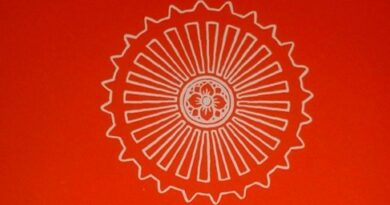Wearing And Donning Robes
Wearing and donning of robes
Wearing and donning of robes are two important matters in the Buddha sāsana. A bhikkhu, who is not accustomed to do it according to vinaya, frequently commit an offence all their lives. Even the one who is concerned about it takes many days to get used to wearing and donning them properly.
Parimaudalan nivasessāmīti sikkhā karauīyā. Parimaudalan pārupissāmīti sikkhā karauīyā. SupaIicchanno antaraghare gamissāti sikkhā karauīyā. SupaIicchanno antaraghare nisīdissāmīti sikkhā karauīyā.
There are four such disciplinary precepts concerning the wearing and donning of robes. “Parimacaalam nivasessāmīti sikkhā karacīyà” meaning here is that, one must get used to wearing the robes evenly without it being at different levels from place to place.
“Uddhan nābhimacaalam adho jācumadalan paticchā dentena jācumanaalassa heiihā janghaiihikato paiihāya aiihangulamattan nivāsānan otāretvā nivāsetabban”.
As given in the commentaries to the vinaya, the andana (inner robe) must be worn to cover the naval at the top and eight angula (eight times the breadth of a finger) below the knee at the bottom. The hem should be level. If one has very long, scarred or very large calf muscles, the robe must be worn more than eight angula below the knee. If the inner robe is too short, the naval may be left uncovered, as it will be covered by the outer robe.
Evan nivāsentassa pana nivāsanan pamācikan vaiiati. Tatridan pamācan, dīghato muiihipañcakan, tiriyan aaahateyya hatthan. Tāditassa alābhe tiriyan dvihatthappamānampi vaiiati.
(Samantapāsādikā)
Those who wear in this manner should have a sufficiently large inner robe. Its dimensions should be, four riyan (Cubit, one cubit = 18 inches) long and two and half riyan wide. When such an inner robe is not available, it is sufficient to use a two riyan wide inner robe.
Buddha has decreed that only one innner robe must be worn. It is not proper to wear one over another. If two are used, they must be held together and worn. It is not wrong to use two because of some disability.
Anto vā ekan kāsāvan tathā nivāsetvā bahi aparan nivāsenti, sabban na vaiiati. Gilānena pana anto kāsāvan ovaiiikam dassetvā aparan uparinivāsetun labhati. Agilānena dve nivāsentena sagucan katvā nivāsetabbāni.
(Khuddakavatthu khandhaka aIIhakathā)
Parimaudalan pārupissāmiti sikkhā karauiyā, the meaning of this precept; One must get used to donning the robe so that it is not at different levels at different places or lower on one side as a sari, but is at the same level on all sides. As much as there is a height, at which the inner robe has to be worn, so it is for the outer robe. It is not stated in the commentaries to the vinaya. “Jācu macaalato heiihā caturangulamattam otāretvā anolambetvā parimacdalameva pārupitabbam”. It is given in the vimati vinodani tīkā (sub commentaries) that the robe must be worn level and four angula below the knee. When the robe is worn in this manner, it will be four angula higher than the inner robe. Parimacdala pārupana is wearing the robe so that its lower corners and the hem are at the same level. It is wrong to wear the robes so that the middle is lower than the corners. Once the robes are donned properly, it is not improper conduct if the levelness is lost due to the corners dipping down. However, when one becomes aware of this the robes must be re-adjusted.
“SupaIicchanno antaraghare gamissāmiti sikkhākarauiyā”. The meaning of this precept; One should go to the village with the body well covered by the robe. It is, described in the vinaya as follows. GauIhikan paIimuñcitvā anuvātantena gīvam paIicchādetvā ubho kauue saman katvā paIisauharitvā yāva mauikhandhan paIicchādetvā antaragharē gantabban. Its meaning; one should go in the inner village with the knot tied and the neck covered by the ends and robe edges kept together and folded again to cover the body up to the left wrist. The making of the knot is mentioned at the beginning of this commentary. It is not to be done before wearing of the robe, but done to show the proper donning of the robe. The knot should be tied after donning the robe. This is a matter misunderstood by many monks. Buddha has stated in the Vattakkhandhaka of the Cullavagga PaIi that the knot should be tied afterwards.
“Timacdalan paiicchādentena parimacdalan nivāsetvā kāyabandanan bandhitvā sagucan katvā sanghātiyo pārupitvā gacihikan paiimuñcitvā dhovitvā pattam gahetvā sādhukan ataramācena gāme pavisitabbo.
This is a para uttered by the Buddha in the Vattakkhandhaka. What is noted here is that the knot should be tied after donning the robes. There is no wrong done by doing it earlier. It is easier to do it afterwards.
This precept is decreed only for the village. The two- parimacdala precepts are applicable to both the village and the temple. Therefore, supaiicchanna pārupana must be done to create the nature of proper covering.
Supaiicchanno antarāghare nisīdissāmīti sikkhākaracyā. The meaning of this precept is that one should travel in the village with the body properly covered by the robe. ‘Galavātakato paiiāya sīsan macikhandhato paiiāya hatthe picaikamansato paiiāya pāde vivaritvā nisītabbam. From neck upto the head, elbow to hands and calf muscle to feet must be left exposed as per the the above statement, given in the commentaries to the vinaya. It is not proper to stay in the village with the shoulders and arms exposed to an extent more than stated above.No harm is done to the bhikkhu who has gone to stay in the village, but lives as he would do in the temple if he so desires.



